Changing Cookstoves Improves Health, Forests and Climate
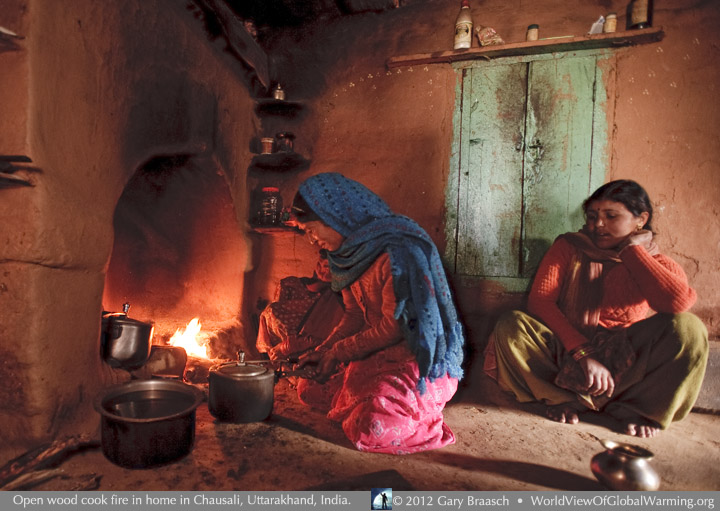
Khasit Devi Latwal cooks dal and rice over an open wood fire, as her daughter watches, in her family home in the village of Chausali in the foothills of the Himalayas near Almora, Uttarakhand, India. Earlier in the morning her daughters fetched the water, waiting to fill containers at the slow-running spring in the village (see the Water portfolio here). Wood burning for cooking in the home has been the way of life for centuries, and some estimates are that two billion people burn wood as well as other types of biomass -- grass, dung and farm residues -- for heat and food preparation. Perhaps as many as three-quarters of families in India burn biomass. Increasingly it is known as a source of unhealthy indoor smoke, affecting the health of all family members. The World Health Organization estimates that about one and one-half million people die of soot-related respiratory and heart ailments yearly.
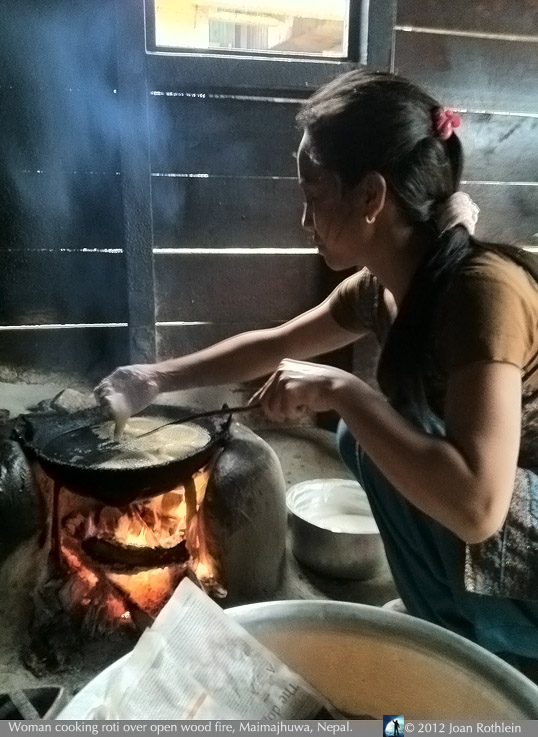
Open fires are used for cooking in small shops and restaurants also, like this roadside store in Maimajhuwa, Nepal where delicious fresh roti (donuts) were being prepared in oil. The smoke rising from a wood or biomass fire is largely soot, also called black carbon, tiny particulates which are also part of diesel smoke. A worldwide drive has begun to cut back on emissions of black carbon not only because of its ill effects on human health, but also due to its large contribution to global warming and the melting of glaciers. Part of this initiative are two signature programs of Secretary of State Hillary Clinton, with the State Department working with the EPA, UN Foundation, UN Environment Program and other governments: the Global Alliance for Clean Cookstoves and a coalition to reduce short-lived pollutants (including methane). Other NGOs like the Climate Institute and World Wildlife Fund also have programs to reduce smoke from home and agricultural fires because of wood burning’s role in climate change and deforestation.
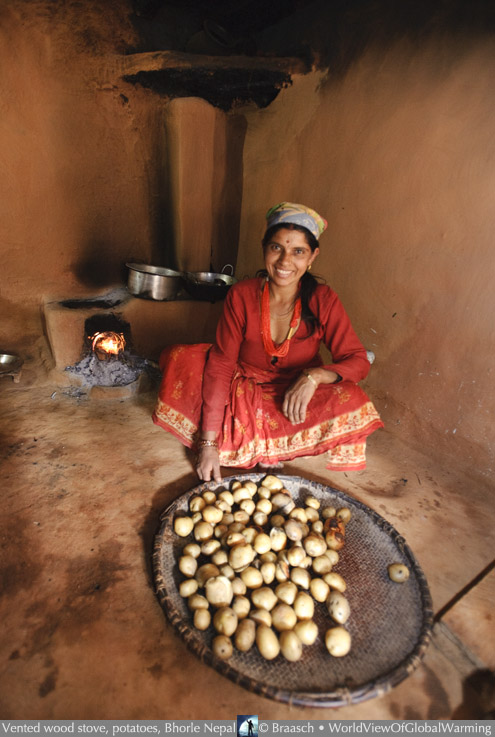
One of the early changes to cookstoves to make them more efficient even while continuing to burn wood was installation of stove pipes or built-in chimneys. This kitchen in Rupsepani, Bhorle, Nepal is typical with a corner stove built into the clay and plaster walls. Aimbik Paudel has just boiled up a batch of fresh potatoes, which she graciously offered to us. Getting the smoke out of the house is one step toward family health, but millions of cooking fires across South Asia continue to sent black carbon into the air. One result of the many tons of soot is that although it is short lived in the air, great amounts are lofted up into the Himalaya and even to the arctic where it settles on glaciers. The black particles and other dusty pollution absorb sunlight, heat up and quicken the pace of glacial melt, according to a recent study by Lawrence Berkeley National Laboratory. The effect in the Himalayas is so strong that the soot could be responsible for almost all the surface melting of glaciers.
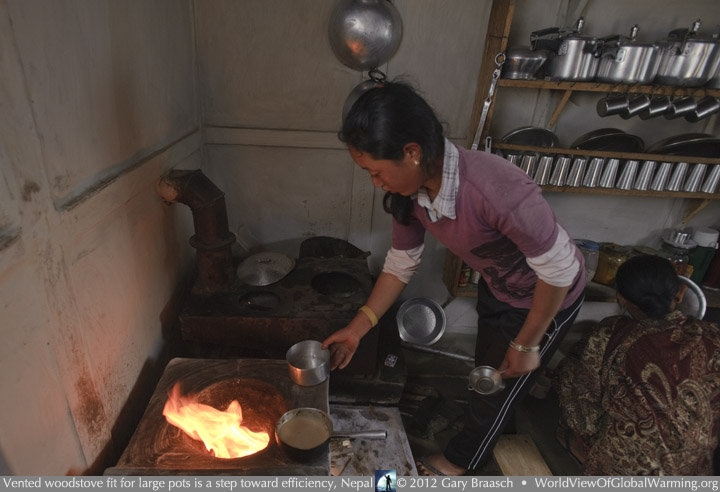
Other innovations and good design have improved the household cooking stove, including metal stoves with better controlled air flow and built in clay burners on vented fireplaces which are made to perfectly fit the large pots of the household. Dinners were delicious and rapidly prepared in this kitchen above Maimajhuwa, Nepal, where we stayed for several days to learn about changing agricultural and grazing practices, with guides from The Mountain Institute. Research into the broader significance of the tons of soot clogging the air of many regions of Asia and Africa has found yet another compelling reason to control it: Even though the particles don’t stay in the air long (days or weeks), while they are aloft they absorb a huge amount of solar radiation. Scientists V. Ramanathan of the Scripps Institution of Oceanography, James Hansen and Drew Shindell of NASA lead independent research teams which reached similar conclusions that in the coming decades reducing black carbon pollution, along with methane emissions, could directly reduce global warming. This is a major reason for the government and NGO initiatives on fire and cookstoves.
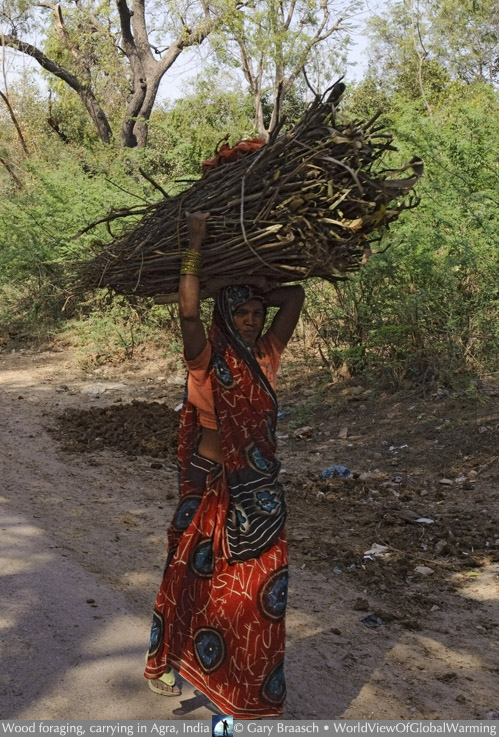
The major cause of global warming and climate disruptions is carbon dioxide, and reducing our emissions remains the most important goal for cooling the planet. CO2 stays in the air for more than 100 years and its effect is building. In the short run, however, the warming effect of black carbon and methane is very strong. The scientists think relatively easy and local controls on burning, vehicle exhaust, landfills, etc. could hold back about half the warming expected by mid-century. And reducing the amount of wood burned has other effects which have brought NGOs like the WWF into action. With much more efficient stoves or gas stoves, women around the developing world will no longer have to gather wood and fewer trees will be cut down -- a benefit not only for people and the land but also for the increase in carbon uptake by forests.
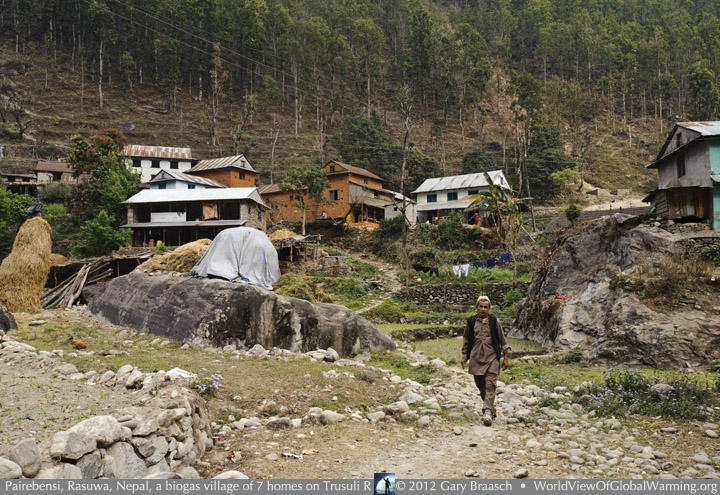
One of the ultimate solutions to the interlocking development issues of waste management, human health, deforestation, farm fertilization and women’s work could be small-scale biogas. Biogas generators using farm manure and in some cases human waste are being installed rapidly, especially through programs which create carbon offsets in the UNFCCC framework. These systems create low-pressure methane piped into kitchens, eliminate the need to cut wood and collect burnable forage from the forests (and cut the need to handle, dry and burn dung in lower elevation areas), reduce health issues from inside smoke and soot, create a fermented organic fertilizer product -- and could slow global warming and the melting of glaciers from soot on the surface of the ice. The 7 households in this tiny village of Pairebensi on the Trisuli River in Nepal were among the first in the mountain foothills to get biogas systems.
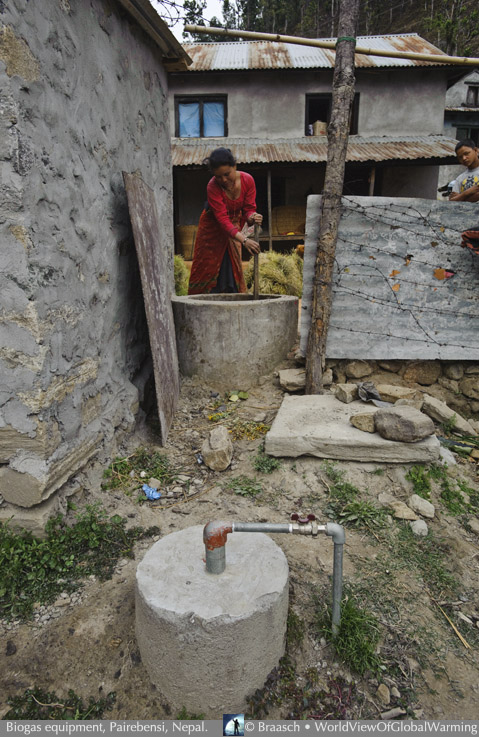
The Pairebensi biogas installations serve 39 family members in the immediate village, and three nearby villages have 8 more systems installed. From the manure of three to four cattle, pigs or goats plus some fodder and plant waste put into the intake (where the woman is in this photograph) and the human waste from the toilet (on the left), a concrete digester tank can produce enough gas (piped out by low pressure, foreground) to cook for 3.5 hours daily on a single stove. The cost in Nepal for these installations was under US$600 each, paid for by grants from WWF and a Nepalese government loan program. Several programs for generating biogas from human and animal waste have been undertaken in the Terai, the warmer lowland of Nepal, but now the technology is moving up into the cooler Himalaya foothills. Higher elevation areas may be too cold for efficient use of biogas, however. WWF Nepal says its first Terai biogas project in the voluntary Kyoto Protocol offset market, which was to install 7500 gas generator systems, created verified offsets of 12,125 tons of CO2.
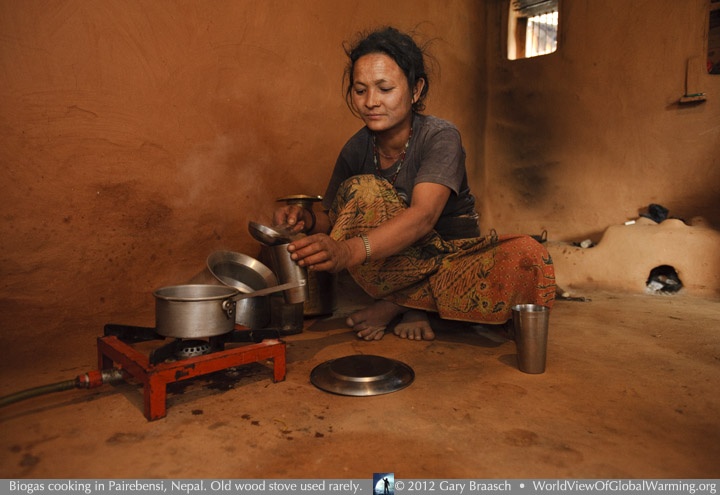
Sangita Gahle cooks on her biogas stove in the smoothed clay common room of her home in Pairebensi, making chai for us while we enjoy talking about families and her joy in cooking with gas. She said the change has made a great improvement in her life. The family used to have to collect firewood three or four times a year, and with the pressure from all the families in the area, their community forest and the buffer zone of Langtang National Park was suffering. Now the forest, which provides fresh leaf fodder for animals and protection from landslides above the village, is much more protected. Sangita said they still keep some firewood around, to burn in the old built-in kitchen stove in case of a large meal to cook or to warm the house on only the very coldest days. Talking and laughing with her and her daughter, drinking tea while sitting on the bed -- under which was stored the latest harvest of potatoes -- we had a great feeling of possibility for Nepalese to be able to protect their land and forests while improving their lives and the climate.
Thanks to all the people who allowed us to photograph and speak with them, and to our guides, interpreters and drivers. Thanks again to the Karuna Foundation - US, the Uttarakhand Environmental Education Center (UEEC), World Wildlife Fund - Nepal (WWF), and The Mountain Institute. Please see other portfolios on the increasing dangers from landslides and how farmers are adapting to changing climate conditions in the Himalayas.
Please see other Himalaya stories in the Climate Changes menu above.
OR
Water | Landslide | Cookstoves | Ganges Glaciers | Bhutan
COPYRIGHT NOTICE:
Photography and text Copyright © 2005 - 2017 (and before) Gary Braasch All rights reserved. Use of photographs in any manner without permission is prohibited by US copyright law. Photography is available for license to publications and other uses. Please contact requestinformation@worldviewofglobalwarming.org. View more of Gary Braasch's photography here.


